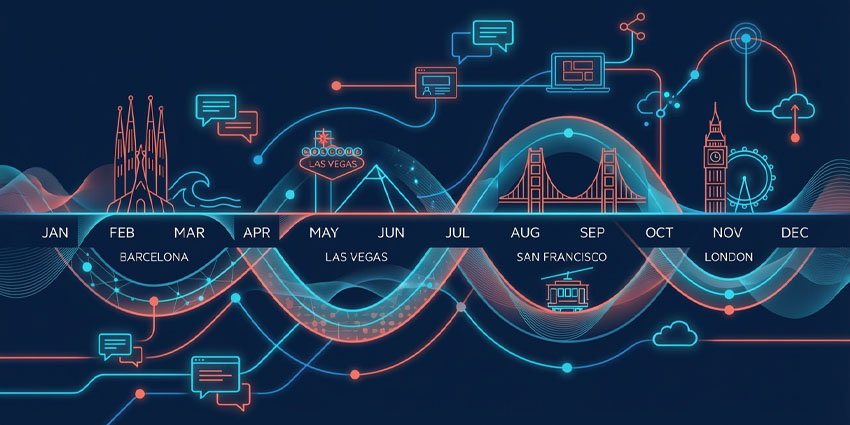In today’s diverse workplace, cross functional collaboration is becoming increasingly crucial to business success. For companies to thrive, innovate, and adapt to changing market dynamics, they must synchronize ideas and insights from employees from various roles and backgrounds.
Cross functional collaboration unites various diverse employees from different segments around a shared set of goals or targets. This process elevates the benefits of collaboration in the workplace, promoting greater innovation, creativity, and a stronger company culture.
Unfortunately, nurturing cross-team collaboration isn’t easy. You need a comprehensive strategy to overcome information silos, conflicts, and other challenges.
In this guide, you’ll learn everything you need to know about cross functional collaboration, the benefits, how it works, and how to ensure you’re getting the best results.
What is Cross Functional Collaboration?
Cross functional collaboration is the process of bringing individuals or teams together from different departments in a team. It connects people with varying areas of expertise, unifying them in a quest to achieve a common goal or target.
Primarily, cross functional collaboration helps to reduce information silos, and streamline the flow of knowledge throughout an organization. It can also create greater camaraderie between teams, and a more positive work environment. For instance, team members working in an environment with high levels of collaboration are 30% more satisfied with their roles.
Cross functional collaboration can happen naturally in an organization that helps to reduce the barriers between teams. A sales manager could easily reach out to a marketing manager over a collaboration app or in person to discuss customer buying trends for the design of a new campaign.
However, in most environments, cross functional collaboration needs to be nurtured and encouraged, by business leaders constantly searching for ways to promote synergy.
The Benefits of Cross Functional Collaboration
For years, companies have been striving to promote better cross-functional collaboration to boost team productivity, enhance company culture, and even improve customer experiences. One survey found that 56% of companies were investing in cross-functional collaboration specifically to improve their relationships with customers.
Implemented correctly, cross functional collaboration can have an incredible impact on your company. Some of the biggest benefits include:
Improved Organizational Alignment
Strategic alignment is crucial in any business environment. In fact, studies show that highly aligned organizations increase revenue 58% faster, and are 72% more profitable than their counterparts. Unfortunately, achieving alignment can be difficult when different departments work in isolation.
That’s particularly true in today’s era of hybrid and remote work, where different groups can often feel isolated from the rest of the organization. Cross-team collaboration serves as a strategy for ensuring all teams work towards the same objectives and goals.
Enhanced Employee Engagement
When team members constantly work with the same groups or on similar tasks for months on end, engagement can begin to suffer. One of the best ways to address this issue is to promote cross-functional collaboration, bridging the gaps between teams.
By connecting people from different departments, employees get to share and explore different perspectives and ideas, which sparks new and exciting conversations. Additionally, the feeling of camaraderie between team members starts to increase, improving overall levels of job satisfaction. One study found that employees who feel more like a “part of the team” were over 200% more likely to stay engaged in their workplace.
More Streamlined Work Processes
Although creating cross functional collaboration can be complex at first, once it becomes the “norm” in your organization, processes can become more streamlined. Team leaders can create workflows for each specific project, that help to naturally bring different employees together, leveraging the various strengths each employee has.
This also helps to eliminate the knowledge silos between departments, reducing disruption in day-to-day workflows by ensuring everyone has access to the same resources and insights. Individual employees spend less time struggling to overcome challenges and more time collaborating with other staff members on creative solutions.
Boosted Innovation and Profitability
Diversity in teams and workplaces is proven to boost both innovation and financial performance. When multiple teams and employees are collaborating in the same environment, more perspectives and ideas have a chance to surface. It paves the way for more diverse thinking patterns, leading to opportunities for creativity and innovation.
Studies even show that working in silos and failing to share knowledge across an organization can cost a company up to $8,000 per day in wasteful expenses. However, highly connected teams, on the other hand, achieve up to 21% higher levels of profitability.
Greater Team Development
Bridging the gaps between your cross functional teams is also an excellent way to promote collaborative growth and development. Team members learn to communicate more effectively, share ideas, and overcome biases. They can even discover how to convert complex ideas into simpler insights for people outside their expertise.
What’s more, managing cross-functional teams challenges business leaders to develop new skills and learn how to support, motivate, and engage people from different backgrounds. This ensures every team member can consistently improve and enhance their knowledge.
Better Company Culture and Talent Acquisition
Promoting the development of cross functional teams throughout your organization is an excellent way to show a commitment to diversity, equity, and inclusion in the modern workplace. This is crucial for a few reasons. It improves your brand’s reputation on a massive scale, and also increases your chances of attracting new talent to your team.
Up to 76% of employees and job seekers now say that diversity is important to them when they’re considering job offers. Additionally, because all of your employees will be aligned, your company culture will thrive, ensuring team members are engaged and satisfied.
The Challenges of Cross Functional Collaboration
Cross functional collaboration can deliver various benefits, but it’s not without it’s challenges. According to one study from The Harvard Business Review, around 75% of cross functional teams in a survey turned out to be “dysfunctional”.
Despite business leaders and managers attempting to ensure cross functional collaboration, teams were still struggling with scheduling issues, budget adherence, compliance, and strategic alignment. With this in mind, it’s worth being aware of the challenges of cross functional collaboration, and what you can potentially do to overcome them.
Challenge 1: Poor Trust Between Team Members
Any business leader can encourage teams from different departments to work together, but that doesn’t guarantee employees will trust each other. If your employees aren’t used to working in a cross functional environment, it can take time to develop and maintain trust.
Fortunately, there are ways to cultivate trust, such as asking staff to work together on smaller cross functional projects before you launch into bigger ones. Give them a chance to get to know each other, share their strengths and weaknesses, and communicate regularly.
Encourage water cooler conversations, whether you’re creating remote, hybrid, or in-office teams, to strengthen emotional connections.
Challenge 2: Misunderstandings and Poor Communication
Some companies launch cross functional teams without a lot of prior planning. They don’t think about how different groups prefer to communicate and collaborate, which can lead to issues when some staff members communicate via Slack, and others prefer in-person discussions.
To ensure communication isn’t siloed, or otherwise problematic, you need to promote over-communication. Encourage people to reach out to their colleagues through a range of challenges. Create meeting agendas that outline exactly what you’re going to discuss in every conference.
Leverage technology to help ensure everyone has access to the same resources, meeting recordings, and summaries, even if they miss out on a video chat or call. Additionally, make sure to broadcast big news, updates, and information to every sector of your team, in a unified space.
Challenge 3: Promoting Remote Collaboration
One of the biggest challenges for modern companies building cross functional teams, is that it can be difficult to bridge the gaps between remote and in-house employees. Some remote team members can still feel isolated from the rest of the team, even if they’re invited to every meeting.
The easiest way to overcome this challenge, is to leverage the right technology and processes. Communication and project management tools like Microsoft Teams and Asana are excellent for keeping everyone on the same page, and encouraging collaboration.
When you’re designing meeting rooms, think carefully about how you can make them more inclusive for hybrid workers. Look at bring your own meeting (BYOM) technologies, and use AI cameras and software to help create a sense of immersion during conversations.
Challenge 4: Preserving a Central System of Record
Teams in different departments throughout an organization often work with many different documents, files, and messaging platforms. In fact, desk workers now use twice the number of apps they did in 2019. If your employees are reliant on different resources, it’s important to find a way to bring all of your tools and software together.
Without a unified system of record, teams can spend too much time searching for crucial information, and the data silos in your organization can begin to grow.
Using a collaborative platform like Microsoft Teams or Zoom Workplace, which can integrate with the tools your team uses, is an excellent way to create a central system of record. You can also use tools like Microsoft’s OneDrive and SharePoint solutions to unify knowledge and data.
Challenge 5: Lack of Goal Clarity
Even if all of your employees should be working towards the same overall business goals, every team and staff member has their own set of priorities. The biggest focus for your marketing team might be to increase awareness, while the focus of your product team is to create innovative solutions.
The key to ensuring success in cross functional collaboration is showing your employees how all of their individual goals align to support a larger goal. For instance, in the example above, different teams might have different smaller priorities, but the overall aim of the business will still be to increase sales and improve customer experience.
Align cross functional teams by showing them exactly how their work connects to the “bigger picture” for your organization, and celebrating every win.
How to Succeed with Cross Functional Collaboration
Cross functional collaboration can transform the performance of your team, and unlock incredible wins, but it requires a strategy. Great cross functional teams aren’t created by accident, they’re developed and nurtured with the support of the right leaders, and technology.
Here are the key steps to succeeding with cross functional collaboration.
Step 1: Create a Cross Functional Collaboration Plan
First, you need a plan for exactly how you’re going to bring your teams together. This starts with establishing your goals for cross functional collaboration. In other words, are you working towards success on a specific project? Is there a specific target you want to reach, like ensuring you get X number of new customers for your latest product or service?
Once you have your goals, connect them to the wider business goals (such as improving customer experience), to create alignment among your teams. Then, ask yourself who should be included in your cross-functional group. Look at:
- The type of expertise and experience you need.
- The characteristics and personality qualities that will work well together.
- The roles each employee will have in your team (what they’ll be responsible for).
- How you’ll track the success of your project (with regular meetings, milestones, project management tools, and key metrics).
- The solutions you’ll need to use to connect your teams (such as collaboration and file-sharing tools, AI assistants, and specific software).
Step 2: Implement Collaboration Tools
Next you need the tools and resources required to support your cross functional collaboration strategy. In today’s hybrid world, it’s usually a good idea to invest in collaboration apps and platforms, like Microsoft Teams, Slack, Zoom, Google Workspace, and Cisco Webex.
Ensure these platforms can integrate with the other critical software and apps your employees use for things like brainstorming (whiteboards), task assignment, project management, and workforce management. Provide your team members with training to ensure they can leverage the resources available to them as quickly, and easily as possible.
At the same time, make sure you have the right hardware available to enable cross functional collaboration. This could mean investing in collaboration displays, cameras for video conferencing, tablets for sharing content, or headsets.
Step 3: Choose the Right Leaders for Your Teams
While cross functional collaboration doesn’t always require a dedicated “leader” or team manager, having at least one or two people at the head of the team can make things a lot easier. Your leaders will be responsible for resolving conflicts, keeping teams on the same page, and ensuring that there’s plenty of regular communication between staff members.
When looking for effective leaders for cross functional teams, focus on:
- Communication skills: Ensure your leaders are comfortable using various communication channels to connect with different groups. Make sure they can communicate clearly and effectively with people from different backgrounds, and segments within your business.
- Decision making: The leaders for your cross functional teams will need to be effective at making quick decisions. Ensure they understand how to weigh up the pros and cons of different strategies and source feedback and guidance from the rest of the group.
- Team building expertise: The best cross-functional collaboration leaders know how to encourage camaraderie between staff members. They’ll know how to boost engagement with team building exercises, run ice breakers in meetings, and resolve conflicts.
- Project management knowledge: Make sure your team leaders are comfortable with project management. Give them the tools they need to track project progress, and make sure they’re aware of different project management methods, such as Scrum and Kanban.
Step 4: Empower Your Teams with Innovation
If you want your cross functional teams to thrive, investing in cutting edge technology could be a great way to overcome common challenges. For instance, if you’re connecting teams from different parts of the world, using an AI-powered assistant can be extremely helpful.
AI tools like Microsoft Teams Copilot can summarize and record meetings for employees who are unable to attend, and even translate conversations into different languages. If your team’s processes involve a lot of repetitive tasks, implementing workflow automation strategies is a great way to ensure staff members don’t get bogged down with things like data entry and updating project timelines.
You can even look into solutions like immersive collaboration, to bring teams from different environments together in flexible digital environments with extended reality.
Step 5: Build Trust and Transparency
A lack of trust is one of the most significant factors that will damage collaboration in any organization. If people can’t trust each other, they can’t communicate openly and effectively. To overcome this issue, look for ways to boost trust between teams.
Team-building exercises and collaborative learning experiences can be excellent ways to forge emotional connections between staff members. Regularly and transparently sharing updates and news with the entire team, through broadcasts on your collaboration channels and emails helps to ensure everyone feels like they’re on the same page.
At the same time, make sure your leaders and managers show trust to team members, by avoiding micromanagement. People in all segments of your workforce need to feel like they’re trusted to take accountability for their actions and deliver the right results. That doesn’t mean you can’t set checkpoints, or use project management tools to keep everyone on track, but avoid being overbearing.
Quick Tips for Cross Functional Collaboration
We’ve covered most of the things you’ll need to know to successfully implement cross functional collaboration. However, there are some additional tips worth mentioning, such as:
- Respect the diversity of your teams. Don’t try to force everyone in your cross-functional teams to work the same way. Allow people to maintain their preferred working and communication styles. If your teams all migrate to the same way of thinking, the innovation you can access through diverse insights will dwindle.
- Give everyone clear roles: Make sure everyone in your team knows what they’re responsible for, and how their work will impact the business overall. Clear roles help to establish accountability, and reduce the risk of employees losing sight of your overall vision.
- Set manageable goals: Set manageable goals for the entire project, rather than just individual teams. This makes it clear to every team member what you’re actually trying to achieve, and what they should be working towards.
- Establish clear communication practices: Tell teams how to communicate about different matters. Arrange regular all-hands meetings, but also let employees know when it makes sense to use chat apps and other tools.
- Provide visibility: Make sure everyone (from your individual employees to team leaders) can track the progress of the project you’re working on. Ensure everyone has a clear view of where they’ve headed, and what they’ve accomplished so far.
- Embrace feedback: Empower individuals to share insights into which parts of your cross functional collaboration strategies are working, and which aren’t. This will help to drive the way for collaborative growth throughout your organization.
- Incentivize: When in doubt, consider incentivizing your team members to engage with cross functional collaboration strategy. Show people what’s in it for them if they branch out and connect more regularly with other staff members.
Make Cross Functional Collaboration Work
Ultimately, cross functional collaboration is a powerful way to drive innovation, improve organizational performance, and engage your team members. Connecting people with different perspectives and expertise throughout your organization breaks down silos, and fosters a more effective collaborative culture.
All you need is the right strategy, the right technology, and consistent input from your teams to make your cross functional campaign work.
Over time, the more frequently your employees work together and share ideas, the more natural cross functional collaboration will become for your entire workforce.







